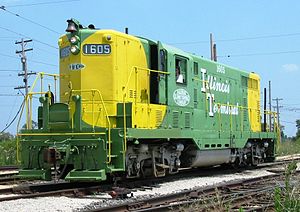EMD GP series
The EMD GP series , English EMD GP (General Purpose) unit or Geeps, is a model series of four-axle diesel locomotives from the US locomotive builder General Motors Electro-Motive Division (EMD).
development
The machines of the EMD F-series are said to have ushered in the end of steam train operations on freight trains in North America . However, these machines were only partially suitable for local freight traffic with its extensive shunting maneuvers . The main points of criticism, in addition to the restricted view to the rear, were the lack of shunting steps and the frontal arrangement of the controls in the driver's cab . However, shunting with steam locomotives was extremely uneconomical due to long idle times and frequent starts. For this reason, the American Locomotive Company (ALCO), a competitor of EMD, introduced the model RS-1, a locomotive series that could be used in both mainline and shunting operations. This series was based on the successful ALCO S-2 shunting locomotive . The underframe was stretched to accommodate a train heater under a small porch at the customer's request. This also made it possible to use it in passenger transport .
This new type of locomotive design was called the road-switcher, German route-capable shunting locomotive. EMD was forced to follow suit. A first attempt to use the mechanical equipment of the EMD F3 in a different locomotive body was unsatisfactory in operation. Despite these shortcomings, in 1949 58 were from April 1948 to May vehicles of the genus BL-2 for 10 different railway companies built. The type designation BL is derived from the English designation branch line, German branch line from.
Only in 1949 was the GP7 a product that was competitive with the Alco models.
construction

As with the previous series, the mechanical equipment of the F7 series was used for the GP7 . When designing the case, however, they went other ways. While the machines of the E and F series were still equipped with self-supporting bodies, the Geeps, as the new series were quickly called, received hoods that were easier to maintain. Until then, this design was mainly used for shunting locomotives. However, the GP7 received a gear ratio for higher speeds. This meant that the machines could also be used on the route.
The mechanical equipment, such as the engine, generator and auxiliary equipment, were housed in the long hood behind the driver's cab. Similar to the Alcotypes, a steam generator for train heating could be accommodated in the short part of the hood in front of the driver's cab. This meant that the machines could be used in passenger train services. However, this facility was not installed on all machines.
A dynamic brake could also be installed at the customer's request. The machines that had this equipment could easily be identified by the additional fans in the middle of the long hood.
With these equipment options, the machines could be used universally. The designation GP for general purpose was derived from this.
The first machines were equipped with the EMD 567 engine series already used in the E and F series . The successor series EMD 645 was used later. All machines were equipped with two two-axle Bo 'Bo' bogies. All four axles were powered.
Series (according to numbering)
| Type | Construction year | number of pieces | power | engine | comment |
|---|---|---|---|---|---|
| GP7 | 1949-1954 | 2,729 | 1,500 hp = 1,100 kW | EMD 16-567B | |
| GP9 | 1954-1963 | 4,277 | 1,750 hp = 1,300 kW | EMD 16-567C | |
| GP18 | 1959-1963 | 405 | 1,800 hp = 1,320 kW | EMD 16-567D1 | |
| GP20 | 1959-1962 | 260 | 2,000 hp = 1,470 kW | EMD 16-567D2 | 66 units with EMD 567C (mod.) |
| GP30 | 1961-1963 | 948 | 2,250 hp = 1,650 kW | EMD 16-567D3 | |
| GP28 | 1964-1965 | 31 | 1,800 hp = 1,320 kW | EMD 16-567D1 | |
| GP38 | 1966-1971 | 706 | 2,000 hp = 1,470 kW | EMD 16-645E | |
| GP39 | 1969-1970 | 23 | 2,300 hp = 1,690 kW | EMD 12-645E3 | |
| GP38-2 | 1972-1986 | 2.219 / 2.222 | 2,000 hp = 1,500 kW | EMD 645E3 | |
| GP39-2 | 1974-1984 | 239 | 2,300 hp = 1,690 kW | EMD 12-645E3 | |
| GP39X | 1980 | 6th | 2,600 hp = 1,910 kW | EMD 12-645E3 | |
| GP40 | 1965-1971 | 1,221 | 3,000 hp = 2,200 kW | EMD 16-645E3 | |
| GP40-2 | 1972-1986 | 903 | 3,000 hp = 2,200 kW | EMD 16-645E3 | |
| GP49 | 1983-1985 | 9 | 3,000 hp = 2,060 kW | EMD 12-645F3B | |
| GP50 | 1980-1985 | 278 | 3,500 hp = 2,570 kW | EMD 16-645F3B | |
| GP59 | 1985-1989 | 36 | 3,000 hp = 2,200 kW | EMD 12-710G3A | |
| GP60 | 1985-1994 | 317 | 3,000 hp = 2,790 kW | EMD 16-710G3 |
literature
- Jerry A. Pinkepank: The Second Diesel Spotter's Guide . Kalmbach Publishing Co., Milwaukee, WI 1973 ISBN 0-89024-026-4 .
- Greg McDonnell: Field guide to modern diesel locomotives . Kalmbach Publishing Co., Waukesha, WI 2002 ISBN 0-89024-607-6 .
- Greg McDonnell: Locomotives - The modern Diesel & Electric Reference . The Boston Mills Press, Ontario, Canada 2008 ISBN 1-55046-493-0 , ISBN 978-1-55046-493-1
- Brian Solomon: EMD Locomotives . Voyageur Press, MBI Publishing Company Minneapolis, MN 2006 ISBN 978-0-7603-2396-0
Individual evidence
- ^ Louis A. Marre and Paul K. Withers: The Contemporary Diesel Spotter's Guide . Year 2008 edition. Withers Publishing, Halifax, PA 2008, ISBN 1-881411-53-2 , pp. 19 .
- ^ Greg McDonnell: Field guide to modern diesel locomotives . Kalmbach Publishing Co., Waukesha, WI 2002, ISBN 0-89024-607-6 , pp. 108 .
